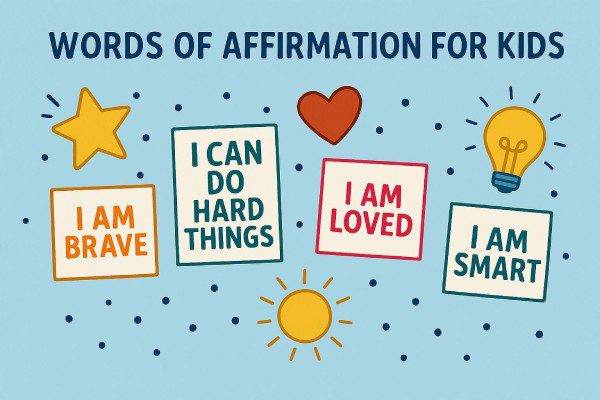Children are under more pressure nowadays than earlier generations from school, friends, and the virtual world. You observe exams and social pressures and eternal beeps of online connection, trying to break their spirit and attention. These pressures are associated with increased prevalence levels of anxiety and mood indicators among adolescents, particularly when the usage of screens is high. The positive affirmation for kids can provide you with a straightforward instrument to help your child take time out and restart.
The affirmation is brief and bright. Once your child says such sentiments multiple times, it can alter the way he/she think about themselves and the day. According to the experts, this type of positive self-talk, which is frequent and common, can help in maintaining mood and coping processes.
What is affirmation for kids?
An affirmation is a kind of brief truth that one desires one’s child to believe. You are plain enough about it. Your child imitates it. In the long run, those words could drive away stressful thoughts and create an inner voice that is more relaxed. Or give it to your child, who you know is true enough to be accepted. As an illustration, one of them is that I can give my best today, or I am learning daily.



It is possible to make affirmations in little bits. Repeat it at breakfast. Hang one up in the mirror. Write one on a lunchbox note. Say one prior to a test. These repeated words of fewer words ground your child to a good thought during stress triggers. Self-affirmation studies present evidence that daily simple affirming statements assist and maintain confidence and stability among students.
Affirmation for kids is not an alternative to professional assistance from a counselor or a teacher if your child needs it. Rather, they supplement other healthy practices you habitually employ. Applaud certain effort. Make a focus on good decisions. Use positive affirmations together with those behaviors to develop resilience and improve your mood. Parents and professionals advise making affirmations a part of daily life, so your child has consistent practice and achieves the desired results.
Empower your child’s affirmation journey while ensuring their online safety.
Benefits of affirmation for kids
Using short, regular affirmations gives your child simple emotional tools. You can help your kids grow stronger inside by adding a few lines to daily routines. Researchers find that self-affirmation can improve how kids handle pressure and solve problems.
Boost self-esteem
Provide your child with effort and value-oriented phrases. As you repeat nice, truthful lines with your child, he/she begin to see strength more frequently. Those repeated messages over the period build confidence in your child and make them less reluctant to explore or attempt something new. According to the studies, values-based affirmations increase the performance and self-perception among injured schoolers who are experiencing identity threats.
Encourage a positive attitude
Affirmation can be used to eliminate concentration on mistakes, but it can also be used in the learning process. Before school, or after a hard moment, say brief, optimistic things. Your child will know how to find small wins and name a single positive during the day. Practice promotes a growth mindset and a more constant mood. Researchers suggest that affirmations should be used together with praise of effort and specific feedback.
Help manage stress or worries
Simply teach your child calming affirmations for tense moments. Practice a simple line before tests or social events. Research shows self-affirmation lowers stress responses and helps people solve problems under pressure. Your child can use these phrases to slow down, breathe, and refocus on what they can control.
Evidence and practical notes
A growing set of studies primarily finds that affirmation for kids offers real benefits when used often and sincerely. Use compact lines that match your child’s experience. Add affirmations to routines like morning, school, plus bedtime so your child gets steady practice and real gains.
Examples of positive affirmation for kids
Use these affirmations for kids as short scripts you speak to your child or put on notes. Keep them simple, honest, and easy to say.
Before school
- You are ready to learn today.
- You can try your best.
- You bring good ideas to class.
Before tests or busy events
- You can take deep breaths and do your best.
- You know how to focus when you need to.
- You will use what you practice.
Bedtime and self-worth
- You did your best today, and that matters.
- You are enough just as you are.
- You grow a little more every day.
During stress or strong feelings
- You can slow down and breathe.
- You notice the feeling, and it will pass.
- You can ask for help when you need it.
For friendships and kindness
- You can be a kind friend.
- You can listen and share it when it matters.
- You help others feel welcome.
For effort and learning
- You learn from mistakes and get better.
- You keep trying, and that matters.
- You can break big tasks into small steps.
Tailoring language to your child
Choose vocabulary to suit the age and life of your child. Brief clauses and a little longer sentences should be used with young and older kids, respectively. Allow your child to alter a line so that it feels true. Having the words correspond with events in your child’s day helps your child accept them better. In order to ensure affirmations work in reality, the specialists advise using straightforward, sincere expressions and practicing often.
How to use affirmations daily
Use these steps to add affirmations to your child’s day. Keep it simple. Make it part of a routine so it feels natural and not forced.



Introducing affirmations to children
- Pick small, true phrases your child can say.
- Start with one or two lines you both like. Practice them aloud for a week.
- Put an affirmation where your child will see it. Try the mirror, backpack, or lunchbox.
- Say an affirmation together at a set time. Try morning, before school, or at bedtime.
- Use affirmations before hard moments. Say them before tests, new social situations, or noisy screen time.
- Let your child lead sometimes. Ask if they want to change a word so it feels real to them.
- Praise the effort behind the words. Notice attempts, not just outcomes.
- Keep sessions brief. One to two minutes of work is best for most kids.
- Repeat gently and often. Small, repeated steps build a new habit.
Best practices for daily use
Always pair an affirmation with a small, simple action. After you say the affirmation, do one short thing, like three slow breaths with a quick stretch or a tiny task. This helps your child turn words into calm, helpful behavior. This helps words become consistent habits.
When dealing with younger children, you can use something fun, such as stickers, hand movements, or little songs. With older children, get them to write a short line in an app with notes or a journal. Monitor using a rudimentary chart. Change words as your child matures in order to keep the language close to his or her experience.
Consistency and customization
To achieve any good, you have to use the affirmations regularly. It is more effective to have a couple of little practices every day rather than have long practices every now and then. You need to alter the wording to the situation, culture, and age of your child. They learn to accept the affirmations more quickly when they are written in co-operation with the child.
Parental controls and using tech with kindness



Parental control applications and guidelines help you shape your kid’s screen use while you teach emotional skills. You can set screen time limits, block risky apps, and review daily usage to protect focus and sleep. A top recommended parental control tool is FlashGet Kids, which combines monitoring and management tools so you can control your child’s device use. Further, you can view app notifications and daily usage to see where your child spends time. You can mirror the child’s screen, take snapshots, and access the remote camera to check the surroundings. One-way audio lets you listen to sound for safety updates. Location tracking and geofences notify you when your child enters or leaves set areas.
Usage reports and alerts flag risky content and unapproved installs so you can act quickly. Social app detection, browser safety, SMS safety, and album protection reduce exposure to harmful content. FlashGet Kids’ “Live Painting” feature gives you a real-time drawing tool to send notes or calming images to the child’s screen.
Addressing common concerns about affirmation for kids
You may ask the question of whether affirmations really do any good and what harm or substitute they may cause to real help. You also want easy means to begin. It is shown that self-affirmation might decrease stress in the context of support of school performance when addressing these issues, along with other resources. Pragmatic parent manuals explain that the most effective affirmations can be implemented through daily routines and new adult modeling.
Select two small lines that accommodate the age and needs of your child. Repeat them at breakfast or before going to school. Place one on a mirror or in a lunchbox note. Make an affirmation with a small ceremony such as a deep breath, fist bump, or silent smile.
Request your child to select words or alter a line. The session should last one or two minutes. Older kids should be able to associate the words with values and strengths through a writing prompt or fast journaling. These are easy steps, and that makes practice easy and consistent.
With the very small children, you can begin affirmations for kids with just ordinary, concrete statements. Short lines are used with actions with the preschoolers. To school-going children, add a little extra about trying or being nice. To teens, they apply values-based, honest prompts and allow them to ponder.
Adjust to your child in terms of language based on the vocabulary and world. Pay attention to the reaction of your child. In case a statement does not sound true to them, it is beneficial to alter the wording and make it sound true.
No. Affirmations assist in self-talk, confidence, and temporary stress. You should not use them as a remedy for severe anxiety, depression, or learning requirements. When your child has sustained mood changes, behaviour changes, and problems at school, consult a teacher or a mental health expert. Make affirmations as a component of a larger strategy, which involves positive parenting, good sleep, exercise, and professional assistance when necessary.
Conclusion
Positive affirmations for kids give you a practical way to build your child’s confidence and calm. Use concise, true statements that match their age and daily life. Practice them in the morning, before school, and at bedtime. Pair affirmations with actions like breathing, praise for effort, and limits on screen time. Let your child choose or change the words so they feel real. Stay consistent and kind when you repeat the lines. If problems last or grow, seek help from teachers or a mental health professional. With steady practice, affirmations can support resilience and happier days. It works best with your warmth.

